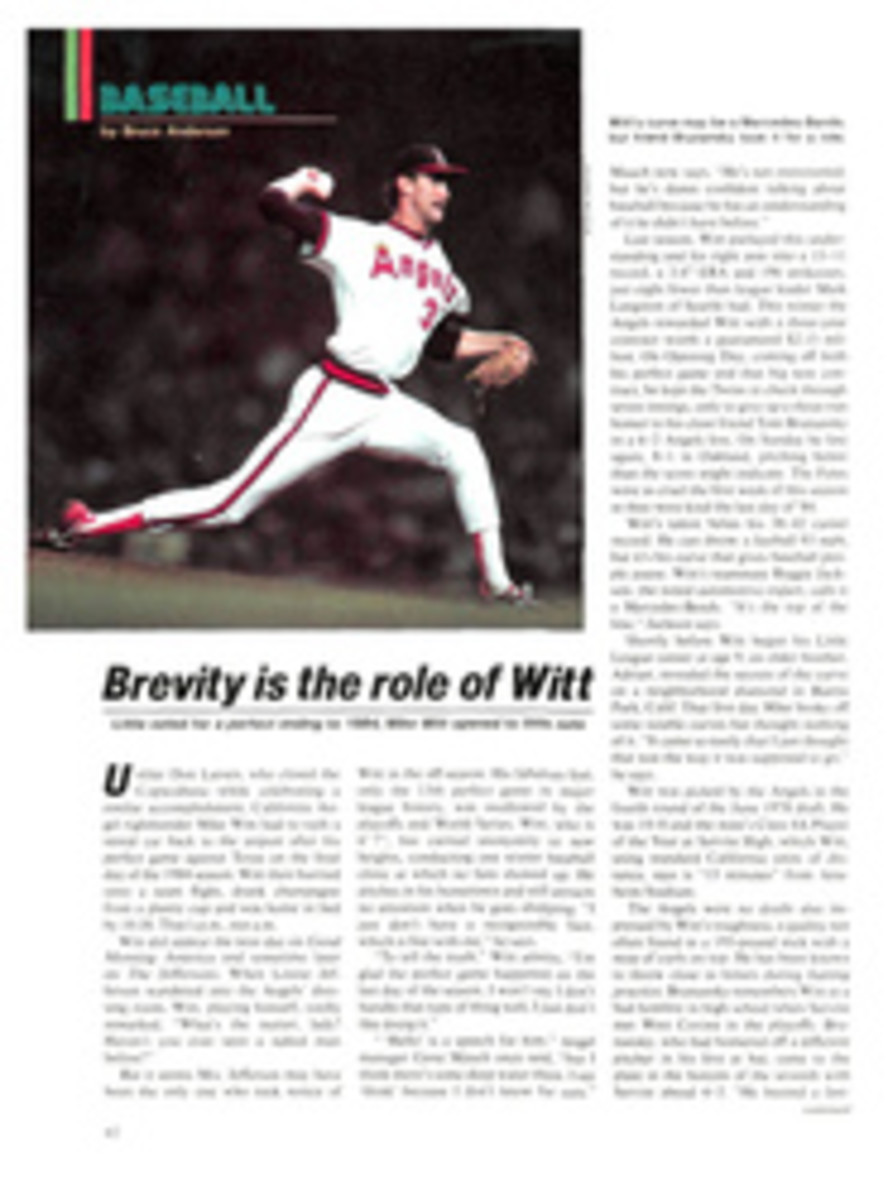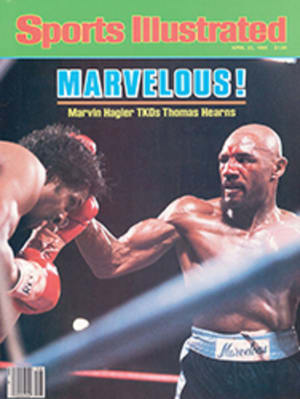
THE DIABETIC ATHLETE: HIS TOUGHEST OPPONENT IS HIS OWN METABOLISM
Former Chicago Cub Ron Santo will remember one at bat long after the other 8,142 have been forgotten.
"September 1968. It was the bottom of the ninth. The Dodgers led 1-0, and the bases were loaded for me.
"But I had broken into a cold sweat, and my tongue was numb and tingly. I stumbled to the plate, seeing triple. I lunged weakly at the first decent pitch, and—God knows how—I connected for a grand-slam home run to win the game. I staggered around the bases, and my roommate, Glenn Beckert, rescued me with candy bars and a Coke."
Santo had experienced the nemesis of diabetic athletes: a plunge in his blood-sugar level that crippled his ability to think and act.
Santo and such athletes as Bill Gullickson of the Montreal Expos, Calvin Muhammad of the Washington Redskins and golfer Mark Lye have the most severe form of diabetes. Their bodies produce no insulin, the hormone that enables body cells to produce energy by metabolizing sugar from the blood. They were stricken suddenly in their youth with extreme thirst and hunger, frequent urination and rapid weight loss. From then on they had to take an injection of insulin daily to live.
The more easily treatable and common form of diabetes, in which the body produces a little insulin, rarely strikes active athletes. It usually develops after age 40 and is often triggered by obesity. It is widespread among just one group of active athletes: Japanese sumo wrestlers, who are so grossly overweight that many become diabetic before middle age.
All 11 million diabetics in the U.S. have to control their blood sugar, but for athletes, male and female alike, this is extraordinarily complicated. Inevitably, competition makes unpredictable demands on the body. And, despite decades of diabetes research, normalizing blood-sugar levels remains less a science than an art. As ex-Philadelphia Flyer Bobby Clarke, a diabetic, says, "Everyone's metabolism is different, and each diabetic has to learn how to cope with his own."
Any athlete who has been keeping his blood sugar in the normal range must deal with a fundamental problem: Exercise lowers the sugar level. A single sprint or jump may make no difference, but prolonged or vigorous activity will force the muscles to burn sugar. If he exercises hard at least 30 minutes daily, the effect of his insulin will be enhanced and he must reduce his dosage by as much as half.
The diabetic athlete can choose from over a dozen types of insulin, ranging from Regular, which peaks in two to four hours and whose effects last perhaps twice that long, to Ultralente, which peaks in 18 to 24 hours and is effective for more than 36 hours. He can also experiment with mixing two insulins for two peaking effects.
He must schedule his shots and decide where to inject them. A runner, for obvious reasons, should not inject insulin into a leg; his leg muscles work the hardest, and the increased blood flow there will use up his insulin too quickly.
An athlete requires more food for fuel than the average person, but deciding what to eat is a greater problem for the diabetic, especially when he's selecting from carbohydrates, the food group with the most powerful effect on blood sugar. Traditional wisdom once held that a simple carbohydrate, like the sugar in ice cream, drives blood sugar up with a quick jolt and should be avoided, except in low blood-sugar emergencies. But recent research shows that simple carbohydrates don't affect the blood sugar as much when eaten along with a meal. Also, some complex carbohydrates, like carrots and white potatoes, raise blood sugar faster than ice cream or even candy bars.
To compensate for the lowering of blood sugar that exercise causes in diabetic athletes, insulin should be decreased or food increased before competition. Besides their mealtime intake, athletes eat carbohydrates during and after competition—usually 10 to 30 grams per hour, depending on how much they exert themselves and how much they've cut back on their insulin doses. And they also keep reliably fast-acting carbohydrates, like glucose tablets, on hand to stave off low blood-sugar emergencies of the kind Santo experienced.
In trying to balance insulin and food intake, diabetic athletes are forever bedeviled by complications. Their bodies work harder and burn more sugar in both extremely hot and cold weather. Women's blood-sugar levels can fall greatly during pregnancy or menstrual periods.
Some athletes get by with few difficulties, but others have to fight an endless battle. One of the unfortunates is Lye. "I carry so much food along," says Lye, "that the guys claim I've got a deli in my bag. One day I had breakfast, then a big lunch, then a Gatorade before teeing off, then three hot dogs, four Cokes and three candy bars in the first 12 holes. The rest of the way I stopped at snack shops.
"That may sound like fun, but believe me, it isn't. Not when you're standing over a putt, so dizzy you could pass out, and you need 10 minutes to recover, no matter what you eat."
Almost every diabetic athlete can recall at least one low blood-sugar emergency. Triathlete Bill Carlson had his crisis during a 100-mile bike ride along a lonely stretch of the Pacific Coast Highway outside Los Angeles.
"It was 7 a.m. and chilly," he recalls. "My reserves of sugared liquid were gone, and I was fading fast. I was just getting desperate enough to break the window of a grocery store when I was saved by a group of French tourists with a cooler of Cokes in their trunk."
It is easier these days for diabetic athletes to avoid such incidents; urinalysis is being replaced with more convenient and accurate tests utilizing instruments called glucometers. Even during competition, perhaps at halftime or between innings, an athlete can prick his finger, put a drop of blood on a chemically treated strip and insert the strip into a hand-held meter to get an exact readout of his blood-sugar level.
For the vigilant diabetic with no vascular problems, exercise is not only safe, but probably beneficial. According to Dr. Ralph DeFronzo, a diabetologist at Yale University, "Diabetics are extremely susceptible to severe vascular problems like blindness, kidney disease, gangrene and heart disease. Although there's little hard evidence, it makes sense to assume that aerobic exercise, which improves circulation, will at least retard the onset of these diseases."
Almost every well-known diabetic athlete has publicly endorsed the benefits of exercise and has lectured other diabetics on how to compete safely in sports. This is a far cry from the not-too-distant past, when many doctors discouraged diabetics from taking part in sports, and the diabetics who competed feared that revealing the disease would jeopardize their careers.
Santo didn't tell the Cubs about his condition for five years, during which time he made the All-Star team three times. Not until five years after that did he tell the public.
There is convincing testimony that a more famous baseball player never revealed that he had the disease while he competed. Jackie Robinson was not only the first black to play in the major leagues, but may also have been the first diabetic.
Robinson and his family always said that he was not diagnosed as a diabetic until after his retirement, but Roy Campanella says otherwise.
"I was Jackie's roommate for a long time before I knew anything about his diabetes, and the other Dodgers never knew," says Campanella. "The only time he talked to me about it was late in his career, when he was considering a knee operation. He said he was afraid 'because I don't think it will heal right, because I have diabetes.' "
Tennis star Bill Talbert, the first famous athlete known to be a diabetic, knew Robinson well, and he believes Robinson developed insulin-dependent diabetes in the early '50s when he was about 30.
"I think Jackie felt it was a weakness," says Talbert. "With all the publicity about blacks in baseball, he didn't want another thing to talk about. His talking was done on the field, and nothing could have been more eloquent."
In general, owners, coaches, players and fans have proved sympathetic to diabetic athletes, as pitcher Gullickson learned in his rookie season with the Expos.
"I hadn't learned how to control my eating yet," says Gullickson. "I brought a sandwich to a game against the Phillies, but I took only one bite. I had a perfect game through three innings, but then I weakened and gave up seven runs.
"The next day I found the rest of the sandwich and a note in front of my locker. A couple of teammates had left a gentle reminder: 'Gully, next time eat a nine-inning sandwich instead of a three-inning sandwich.' "

